article updated on 1.24.2024
Whether you call them best hiking poles or trekking poles it’s impossible to deny their value on a backpacking trip. Today it’s more common to see hikers with poles than without. But this hasn’t always been the case, has it?
At a Glance: My Top Recommendations for Best Trekking Poles
- LEKI MCT 12 Vario Carbon Trekking Poles
- Black Diamond Distance Carbon Z
- Mons Peak IX Tiger Paw Carbon Trekking Poles
- Cascade Mountain Tech Aluminum Quick Lock Trekking Poles
- LT3 C (FIXED) HIKING POLE
Note: Clicking the above links will take you to further information, current prices, and customer reviews on Amazon
Most of you will remember the days of hiking sticks before commercial best hiking poles gained popularity. Thanks to modern research we now have studies revealing the health benefits of hiking with poles. And companies have given us high-tech trekking poles to get us further, faster, and easier.

With hundreds of nights of experience guiding backpacking groups across the US, I know what makes the best hiking poles – and what to avoid.
Let’s take a look at some of the best hiking poles on the market right now and how to choose them.
Table of contents
- At a Glance: My Top Recommendations for Best Trekking Poles
- Best Hiking Poles: Reviewed
- How to Choose the Best Trekking Pole for You
- Types of Pole Design
- Trekking Pole Techniques
- How to Measure Trekking Pole Length for You
- How to Repair a Trekking Pole
- Conclusion:
- FAQS
- Geek Out on Camping Gear? Read More Articles Below
Best Hiking Poles: Reviewed
LEKI MCT 12 Vario Carbon Trekking Poles
LEKI makes some of my all-time favorite lightweight backpacking gear – but it doesn’t come cheap! I’ve been using their backpacks and hiking poles since 2011 and they’ve only improved. This year’s LEXI poles are no exception.
- 10.4 ounces per pair
- fixed length, three options: 110, 120, 130 cm/li>
- Push button lock mechanism
- Full cork grips
If you’re a gram weenie like me, you’re paying attention to every ounce. You’ll be hard-pressed to find a lighter 3-piece pole with better construction than the MCT 12 Vario’s.
At 7.3 ounces, both poles together add up to just 0.90 pounds of weight. Don’t worry though, if that’s too heavy for you purists out there, you can go with the LT3C poles, which come in at a tiny 2.7 ounces each (I own these).
The MCT 12 Vario’s have the extremely lightweight qualities LEKI is known for while still being adjustable. Adjustment is critical for storing, packing, and transporting – particularly on planes and buses.
LEKI also sells replacement pole sections so you can do your repairs. You’ll rarely need this, but accidents happen, and at least this way, you don’t have to buy a new pole.
Because these poles are sold in three different lengths, you’ll want to choose the pair for your height. Three options for length: 110, 120, 130 centimeters. They’re also great for setting up lightweight tents or tarps.
Best for ultralight hikers who need a small collapsible pole they can easily transport and pack.
Priced on Amazon for:
Black Diamond Distance Carbon Distance Z-Poles
Black Diamond has been making mountain equipment for decades and they do it right. I’ve been a huge fan of these poles which were quite revolutionary when they came out. Today they’re still one of the best choices available.
- 9 – 10 ounces per pair (length dependent)
- 3-piece non-adjustable
- EVA foam grips
Both foldable and adjustable poles can be collapsed down to store and transport. These poles break down into 3 pieces connected by an inner core wire. Meaning, when they’re deployed, they’re locked into a single length and can’t be adjusted.
The pole grips themselves have two different gripping areas. One of these is at an appropriate height for normal hiking and the other is at a good height for climbing hills. So they (kind of) are adjustable, as long as you order the right size in the first place.
These poles may be inadequate for tents that rely on adjustable height poles for setup – rare but they do exist.
Best for a lightweight, simple pole that’s affordable and easy to use.
Get it on Amazon for $174.95
Mons Peak IX Tiger Paw Carbon Trekking Poles
I put this pole on our list not because it’s the best pole of all time, but because it offers value. Not everyone wants the lightest possible pole, but sometimes we want some advanced features. Sound like you?
- 13.9 ounces per pair
- 4 season use
- Tips and baskets included
- Silver on Black markings to assist in low light visibility
- Telescoping tubes retract to compact 24.5 inch
- Adjustable wrist straps
- Cork+foam comfort grips
At 13.9 ounces between them, these poles are behemoths compared to our first two lightweight poles. If they’re not a pick for gram weenies, who are they for?
Well, their fully adjustable height, combined with an extra-large cork and foam grip, gives hikers tons of options on how to use them. They are made from carbon fiber to lighten them up compared to aluminum poles.
While none of that is remarkable by any means, their true strength lies in the balance of weight per pair and price.
It’s worth noting that unlike the Gossamer Gear or Black Diamond poles, these lock into place using a polymer snap-click compression lever mechanism. These systems are a little heavier, but they’re more versatile and simpler to use especially for those with creaky hand joints.
Best for a light, adjustable hiking pole at a price that won’t break the bank.
Get it on Amazon for $149.95
Cascade Mountain Tech Aluminum Quick Lock Trekking Poles
This time we move further from lightweight and closer to affordable. Of course, if you’re strapped for cash and want a Featherlite pole, these aren’t for you.
But if you prefer to spend light and don’t mind carrying some extra weight, these are great!
- 20.8 ounces per pair
- 3-piece lever lock adjustment mechanism
- Cork & rubber grips
These hiking poles make our list for a specific reason: affordability. I wanted to make sure those with tight budgets have an option they can fall back on.
One area where these poles exceed the specs of other poles on our list is with the tip adapters. Most poles come with a mud basket or a snow basket, but these also feature flat rubber tips and curved rubber tips. Good for walking or standing on pavement, rocks, or tricky terrain.
Before you buy these remember that any additional weight on the feet or in the hands is much more tiring than weight in the pack. Like many scientific and empirical research studies, it’s easy to point to footwear and hiking poles as energy-draining gear on the trail.
These poles are affordable enough that they might make a good choice for beginners who are unsure if they will continue to use poles when hiking.
Best for those on a budget. Or those on a supported trek, like Kilimanjaro, where weight isn’t such an issue.
Get it for $29.99
LT3 C (FIXED) HIKING POLE

Last but not least is my all-time favorite hiking pole. So, why is it last on the list? Because it’s definitely not for everyone! They’re a single-length fixed pole and they cost a pretty penny.
Features:
- 5.4 ounces per pair
- Single piece fixed length
- Cork grips
These compact hiking poles have been my trusted companions for years. They’re strong, sturdy, yet weigh only a little over 5 ounces together which is stupid lightweight!
At the bottom of the pole, a wrap of reinforcing carbon fiber strengthens it. Without this they’d be too easy to snap or break but as it is, they’re durable for their weight.
The cork hand grips are great quality, full cork that’s soft and absorbent. On the back are lightweight microfiber-lined wrist straps that are comfortable and adjustable.
Like most ultralight gear, you can customize them by removing the straps and baskets if you want. And before you ask, yes the tips are replaceable like any good hiking pole.
Beware, as the fixed-length pole means they’re unwieldy on public transport to and from the trail. It’s also difficult to store them in your pack if you’re climbing or scrambling and don’t want to hold on to them.
Best for ultralight purists who want the lightest pole known to man!
How to Choose the Best Trekking Pole for You
Hiking Pole Weight
One of the most essential factors in deciding on a hiking pole is their weight. Of course, it’s not the be-all and end-all, but it’s essential.
Why? Because pole weight has to be carried all day long. You’ll be moving them up and down thousands of times a day.
Would you preferably move a 10-pound hiking pole all day or a 1-pound hiking pole? Of course, the best hiking poles are much lighter than this, but it’s the same idea with a 10-ounce hiking pole versus a 5-ounce hiking pole.
If you don’t think pole weight will bother you, then consider that heavier poles will weigh down your pack when stored. Many hikers stash their trekking sticks in their packs during certain stretches, and those poles now become part of your pack weight.
There are a few actual reasons to go with a heavier pole. One reason may be concerns about durability. While I’ve yet to have a problem, even with the lightest poles I’ve ever hiked with (2.7-ounce Gossamer Gear LT3C poles) you may prefer something sturdier for peace of mind.
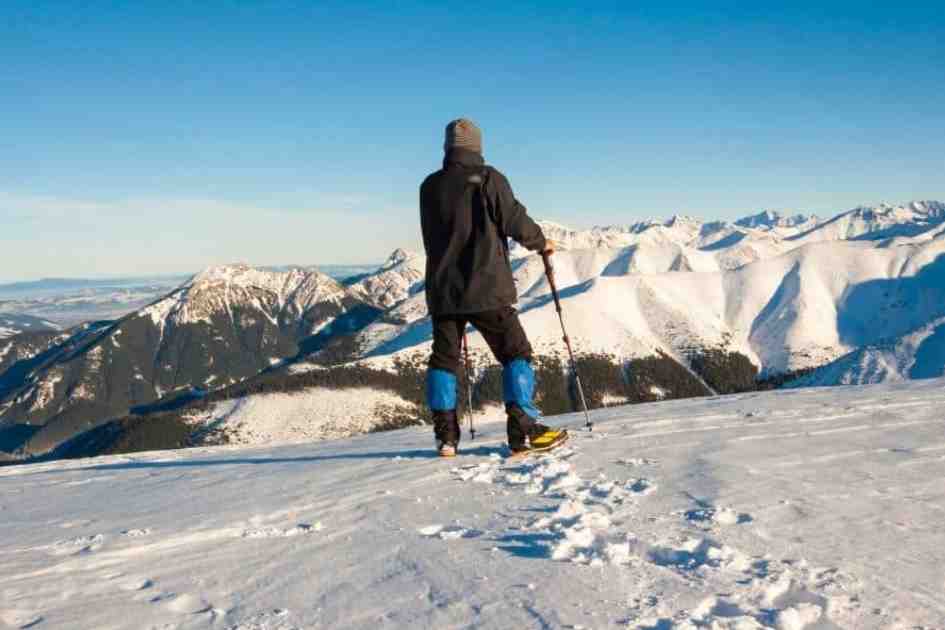
Adjustable Hiking Poles
Hiking poles most often come with some form of adjustability. The real issue is whether or not this is necessary. I mean, adjustment mechanisms cost more and weigh more – but do we need them?
For any single hiker, two lengths of hiking pole are “necessary”:
- You need one length for hiking on flat ground (full length)
- A slightly shorter length for hiking uphill
This assumes that you bought the correct length in the first place.
Creative manufacturers keep weight down by extending the hand grip to provide two distinct gripping lengths in a single pole. This removes the need for heavy and expensive adjustability mechanisms.
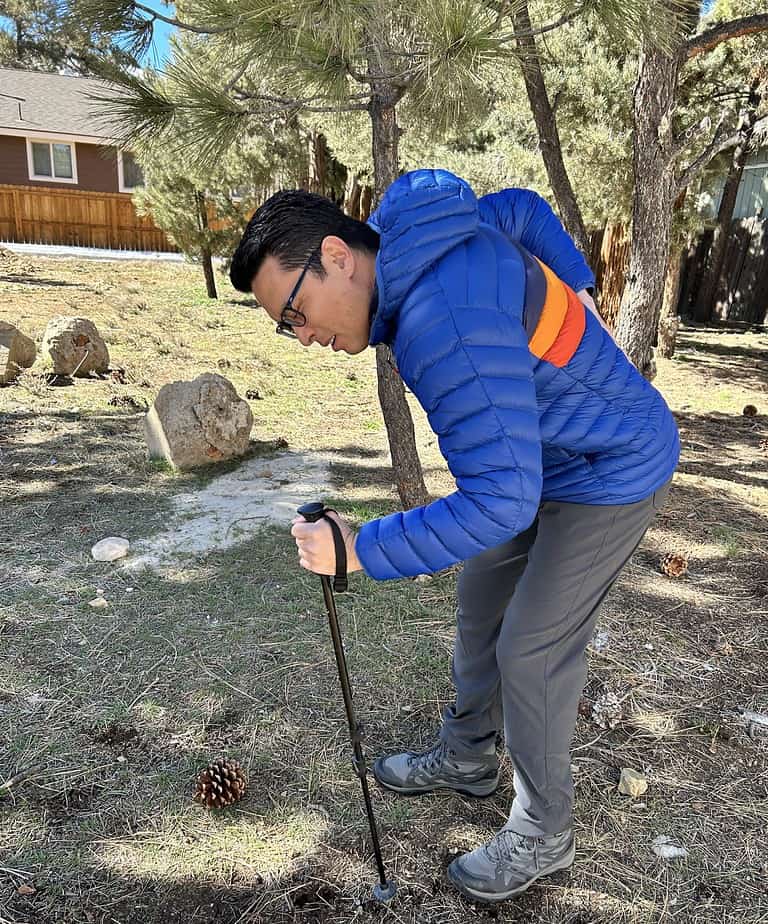
Many hikers fail to size their poles correctly. If you’re using your poles for more than one sport, you may want fully adjustable poles. To use your poles for hiking, skiing, and snowshoeing each sport will need a different length. In this case, adjustable poles are great!
Poles with adjustable length are fantastic for using with shelters that need a hiking pole as part of their setup. Some ultralight tents and tarps operate this way and if that’s the case you may need a pole with an adjustment mechanism.
Types of Pole Design
Single Piece Fixed Length Poles
are set at a predetermined height when you order. These poles generally have longer handle grips to allow for more than one grip type. An example of this style is the Gossamer Gear LT3C.
- Lightest weight
- Hard to transport
- Can’t be adjusted
- Can be inexpensive
Multi-piece Fixed Length Poles
Are set at a single length when you order them but are collapsible for transport. These poles usually have long handles to allow multiple grips and are easier to pack and travel with than single-piece poles.
- Lightweight
- Easy to transport
- Can’t be adjusted
- More expensive
Twist Lock Adjustable
These are generally 3-piece telescoping poles that can be set to different lengths. Twisting the barrel of the pole causes the pieces to self-lock. These poles can range dramatically in quality and price.
- Midweight to very heavy
- Easy to transport
- Full adjustability
- Range in price
Adjustable Folding Poles
It is a hybrid pole where the bottom two segments are non-adjustable while the topmost grip section remains adjustable. They are a balance of lightweight and adjustable.
- Midweight
- Easy to transport
- Full adjustability
- Mid-price
Flick Lock Adjustable Poles
These can also be called “lever locks” or similar terms. They’re fast and easy to adjust featuring a small lever on each section which can be opened and closed to allow for any adjustments.
- Midweight to very heavy
- Easy to transport
- Full adjustability
- Range in price
Shock Absorbing Poles
These seem to be one of the mysteries of outdoor marketing in the modern world. Shock-absorbing poles popped up out of nowhere and seem to be here to stay. But, what are they?
Shock-absorbing poles feature a fancy spring inside the main tube that absorbs some kind of shock. However, there’s a big problem.
I’ve spent thousands of hours on the mountain using hiking poles, alpine ski poles, and cross-country poles. Never once have I said, Damn, using these poles is too shocking on my arms, I need some springs in there.’
I’ve used shock-absorbing Leki poles which are some of the “best” on the market. They didn’t seem to add anything but weight. I’ve used cheap shock absorption poles which were far too heavy.
I’ve also used single-piece fixed-length carbon poles with zero shock absorption capabilities.
In all my experience and conversations with other hikers and guides, I’ve never met anyone who finds shock-absorbing poles valuable. Unless you’re sword fighting with them, you shouldn’t be stabbing them into the ground hard enough to generate a “shock”.
That said, if you have particularly sensitive musculoskeletal issues, perhaps the shock-absorbing poles could help you. I’ve not experienced that yet so I can’t speak to their effectiveness in such a situation.
Shaft Materials
When it comes to constructing the shaft of your hiking poles, there are two main materials.
Aluminum is sturdy and cheap. It may bend or kink if abused but can sometimes be straightened out.
Carbon fiber is much more expensive but very lightweight. It will not bend or kink and if abused it will “snap” and splinter, destroying the pole.
I’ve only ever messed up a pole one time in all my years of hiking and skiing. I stabbed an aluminum hiking pole too far into the snow when spring hiking, then slipped and pulled it down with me. The pole’s tip didn’t give, and my weight jerking sideways caused the pole to buckle. It was my fault.
Grip Materials
Putting a good grip on any hiking pole is super important. Cheap poles come with hard plastic or rubber grips that chafe and cause discomfort. Good poles mean great handles, but what kind of materials are they made from?
Cork is my favorite. It’s naturally sweat-absorbing, soft, and over time will conform to your unique grip style.
EVA Foam is a great alternative. It’s durable and absorbs sweat well. EVA Foam is inexpensive to produce on pole handles and is very soft to the hand.
In my view, there’s not enough difference between the two materials to bother a buying decision. I’d take a cork handle over EVA foam grip but it’s not a big deal.
Avoid other materials as they’re uncomfortable and will cause rubbing and chafing, leading to nasty blisters. Rubber and plastic are unacceptable materials for hiking pole handles in my world.
Trekking Pole Wrist Straps
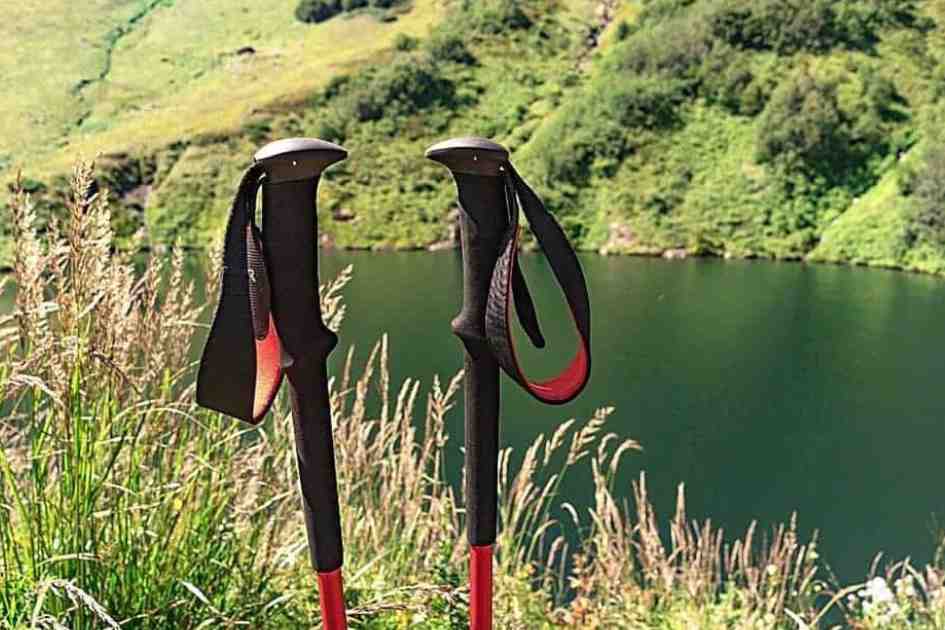
With hiking poles, there’s one mistake more common than any other. Improper strap use is prolific on the trail. It’s unlikely to hurt you, but you will lose many benefits by using the strap wrong.
To use the strap on your pole, insert your hand from underneath. Then grip the pole with the strap trapped in your palm. The strap should support your hand in a natural-use position on the pole handle if you relax your grip.
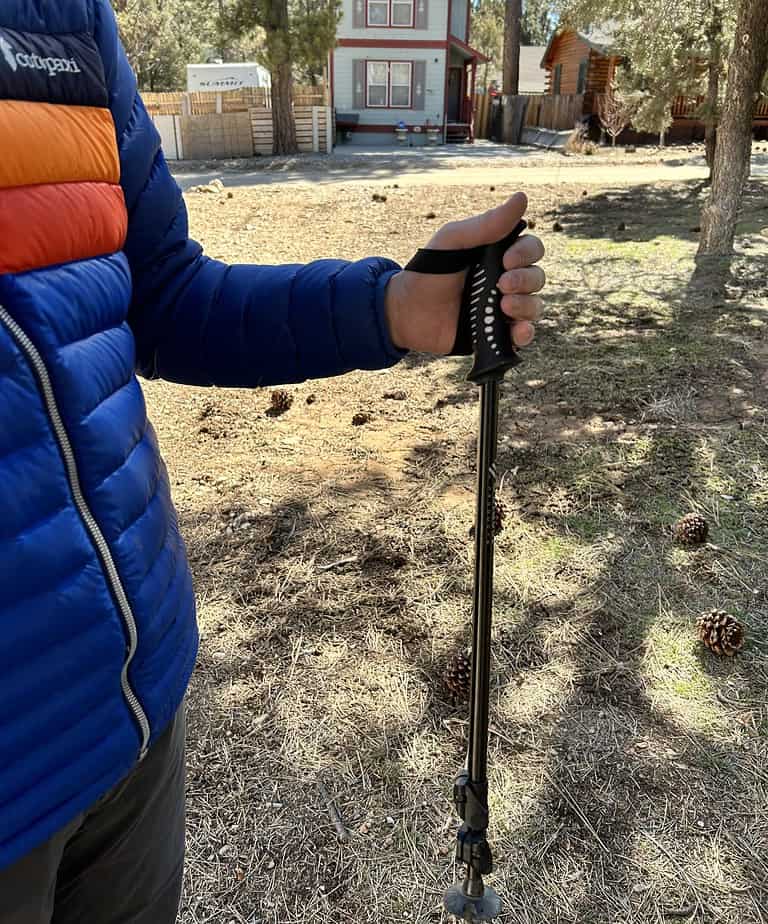
Using the pole strap in this way you can use your wrist and arm to “push off” as you plant and walk past the pole each step. Consequently, this method reduces the stress off your hands and fingers, so the bigger joints of your arm are doing most of the work.
Despite the poor quality of the video, this Leki video covers all you need to know about using pole straps:
Trekking Pole Tips
The tip of your pole which makes contact with the ground is generally made from very hard metal. Carbide tips are the most common and they’re super hard allowing them to bite into rocks, sidewalks, and dirt without wearing down too quickly.
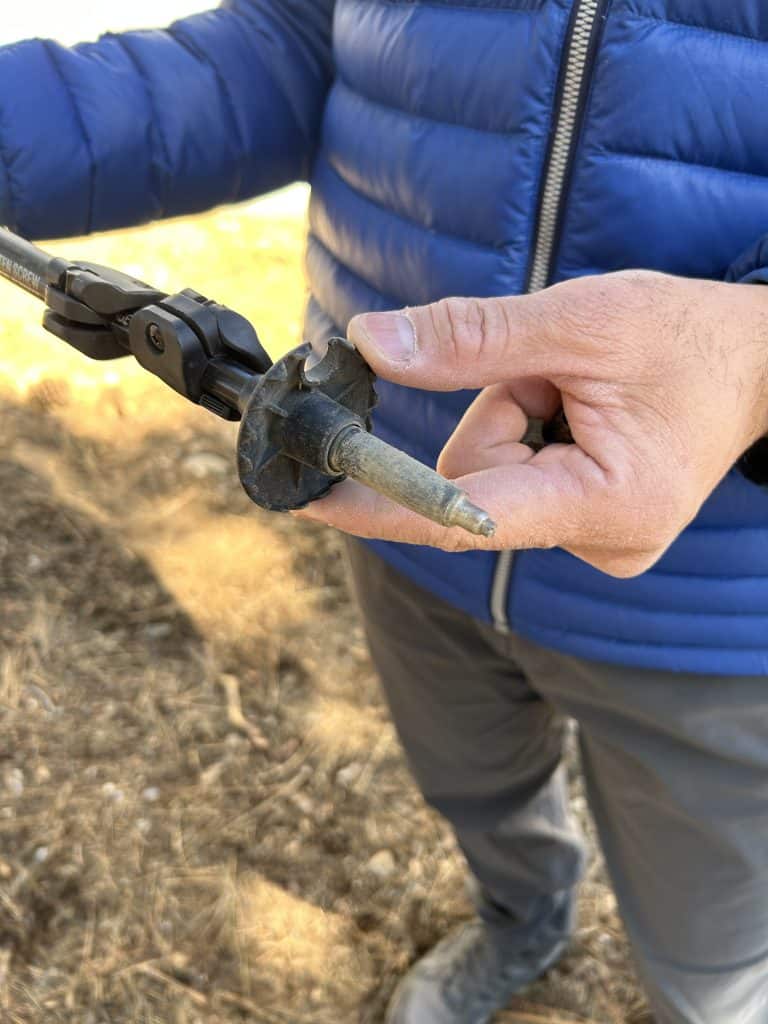
The problem is they can mar, scratch, or dent nice surfaces such as finished sidewalks or boardwalks.
So, what’s the solution?
Rubber tips come in several flavors and help protect the world around you from the aggressive carbide tips of your hiking poles.
There are rubber tip protectors for hiking, walking on concrete, and transport. They’re easy to buy and replace. Plus, many hiking poles come with one or more types of rubber tip protectors when you order them.
Remember that those carbide tips will eventually wear out. For most people, this happens over several seasons. Thru-hikers may wear through several in a single season. They’re cheap and easy to replace with a visit to any outfitter.
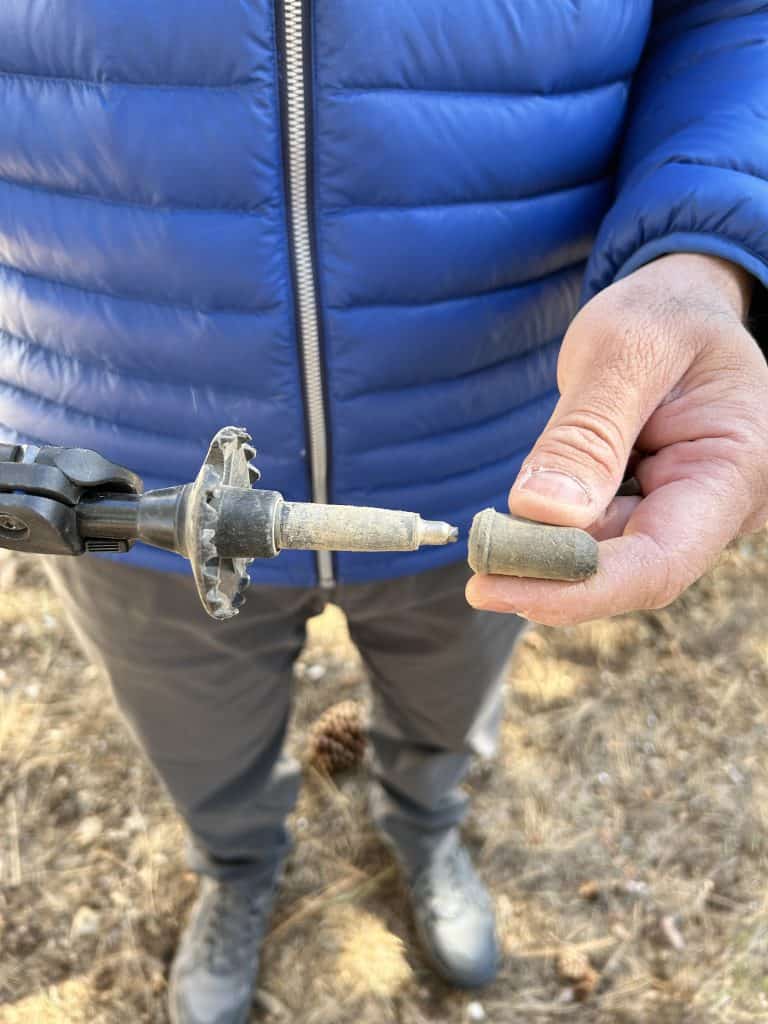
LNT NOTE: Carbide hiking poles can tear up dirt, wood, and even rock surfaces. They leave permanent marks on the world around you. Consider using rubber tips to minimize these impacts, especially in heavy-use areas.
Hiking Pole Baskets
On all types of poles, baskets are the circular ring around the pole about 2? above the tip. These are here to prevent the pole from sinking too deep into the ground, mud, or snow.
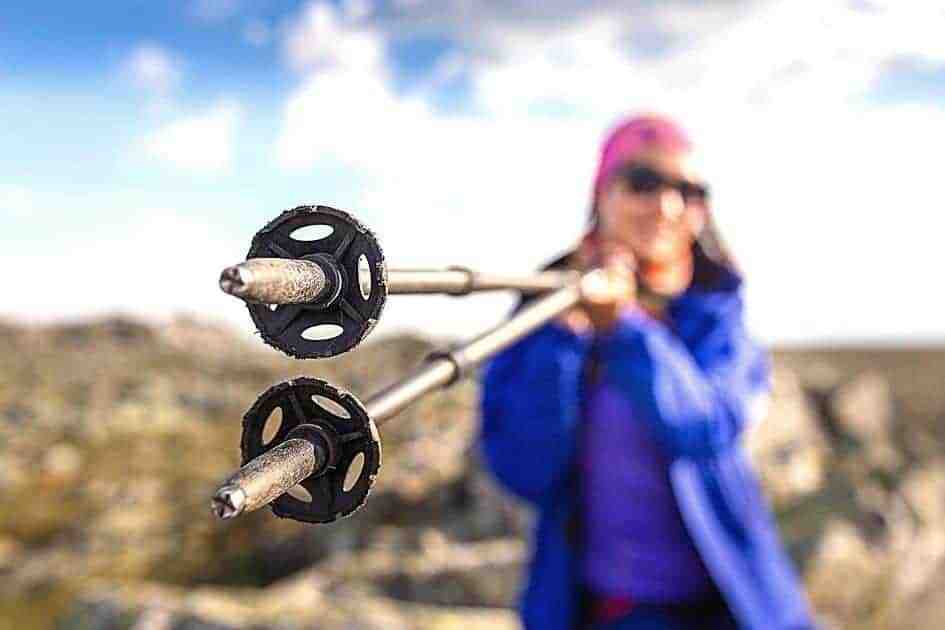
I’ve done a lot of hiking with trekking poles and I’ve never used mud baskets, they seem like a waste of space in most cases.
Sometimes they can be handy to prevent your pole from slipping between a crack in a rock or similar, but I’ve never had a pole sink into mud so badly that I needed a basket.
That said, they could be handy in sand or other super soft surfaces if you’d like something to spread the weight.
If you’re hiking or snowshoeing in snow deeper than about 6? you’ll want a powder basket. These are much larger 4? or so diameter baskets. They help keep your pole on top of the snow and spread out the force of your pole so it doesn’t sink.
They’re most useful in deep soft snow such as areas where very deep powder accumulates. Chances are good you won’t be doing much trekking in these areas. You’ll more likely be on skis or a snowboard.
I do not use any basket at all on my poles when backpacking.
Recommended reading:
How are Trekking Poles Different From ____ Pole?
Good question! Hiking or trekking poles are their unique animal. They’re sized and used differently than most other poles.
Alpine skiing poles have to be adjusted for the type and style of skiing as well as the skiers’ preferences. They’re stiffer and have powder baskets or snow baskets.
Cross Country or Nordic Skiing poles are much longer than other poles. They feature asymmetrical baskets with a very sharp backward-facing metal tip for gripping and pushing in ice and snow.
Hiking poles are set to a length based on the height of the user with hiking boots or shoes on. They are often adjusted to different lengths for uphill vs downhill.
Snowshoeing poles are set and used in a similar way to hiking poles. The main difference is the use of powder baskets and adjusting the poles for the height difference of the snowshoes.
Trekking Pole Techniques
Once you’re out on the trail it’s time to put those poles to work. Just stab ’em into the ground and stomp along on your way, right?
Well? maybe not so much.
While pole techniques vary based on the sport at hand, hiking poles have a distinct method.
Pole use for propulsion
Most of the time, you’ll want to plant the opposite pole of your forward foot approximately at the same level as your foot. That means if you’re stepping forward with your left foot, the right pole should be planted at about the heel distance of that foot.

Avoid planting your poles too far forward. This will usually result to “pull” yourself forward rather than push. Your poles and arms are most effective when the pole tip is at your midline or behind, and you’re able to push with the pole as if propelling yourself forward.
When doing this with a proper wrist strap setup, you’ll find that your arm can push directly into the pole to help speed you up and move you forward.
Pole use for balance
is a common practice that is often integrated with each step. We don’t think about it, and there’s not much of a technique to it.
Be careful of losing your balance and stabbing a pole out blindly to catch yourself. Poles can skitter off rocks or get trapped in a nook which will send you reeling or falling onto the trapped pole.
Ascending a shelf
If you’re making a large step up such as climbing a rock, you may want a boost. In this case, plant both poles firmly and push downwards on them as you step up.
Don’t expect the poles to do all the work, you’re giving your legs a little boost. Poles are not meant to take the entire load of your body and your pack.
Stabbing your poles is not a proper technique. If you’re “stabbing” into the ground, you’re putting too much effort into it and leaving a lot of visible scarring behind you for others to see. You should be placing your poles, and applying gentle pressure as you use them. It is not a laborious process.
How to Measure Trekking Pole Length for You
Everyone has a different body height and shape. So it stands to reason that the right pole length for you is different than the one for me.
There are two ways to measure the height of your pole.
Without a pole
you can stand at normal height with your elbows bent at a 90-degree angle and measure the distance from the bottom of your hand to the floor. Do this with your fist loosely closed and knuckles facing forward as if holding a cup of coffee.
With a pole

you can decide on the right size by holding the pole by the grip. When doing this, with your hiking shoes on, your elbows should form a right angle or a little higher than a true right angle.
This is much less important for adjustable poles than fixed lengths. It’s critical to get your measurement right with a fixed-length pole as you can’t change it later.
You’ll want to make sure that you set your adjustable pole to the right height by using these same methods.

How to Repair a Trekking Pole
If your trekking pole breaks, you’ll have to buy a new one. It’s that simple.
Aluminum poles may bend slightly, in which case you can try to straighten it out or keep using it as-is. I know plenty of people with bent and dented aluminum poles. So long as they’re not unusably bent, you’re fine.
Be warned: aluminum can break. Bending aluminum more than “just a little” may cause it to snap and break completely.
For carbon fiber trekking poles, if you break it, you’ll know. They snap, there’s no bending or unbending for carbon poles. That said, they can take a lot of abuse so it’s not very common.
In an emergency, you can try to brace it with sticks or tent poles and use some duct tape to fix it.
Some trekking poles have replaceable sections, such as the Gossamer Gear LT5. In this case, you can repair your pole without having to buy a whole new one. It’s easier on the wallet and better on the landfill. Nice!
Advantages of using hiking poles
Congratulations, you’ve made it to the end of one of the longest trekking pole articles I’ve ever written. I hope it was helpful and didn’t make your eyes glaze over.
When choosing hiking poles, it’s crucial to consider their durability and comfort, much like selecting the right type of shelter for your outdoor adventures. For a detailed comparison on shelters, check out our guide on frame tent vs pole tent.
There’s a lot to know about outdoor gear and you’ll learn it all in time. At this point, you should have an expert level of knowledge about hiking and trekking poles.
You’ve learned how to pick them out and how to use them. Now it’s time to make a purchase you’ll be happy with.
Go revisit the hiking pole reviews we put together for you. There you’ll find the poles you need. I’ve made sure the best of the best for several categories, such as lightweight backpacking tents, and mountaineering ice axes, are included so there’s definitely going to be something for you!
Conclusion:
As we wrap up this comprehensive guide on the best hiking poles, let’s take a moment to reflect on the transformative power of a great pair of poles on your hiking experience.
Whether you’re navigating or pitching a mountaineering tent in rugged terrain or embarking on a leisurely trail walk, the right hiking poles can significantly enhance your stability, reduce the impact on your joints, and boost your overall hiking efficiency.
Remember, the key to finding your ideal hiking or trekking companion lies in understanding your specific needs – do you prioritize lightweight design, durability, shock absorption, or adjustability? Our top picks, tailored for a range of hiking styles and budgets, are designed to guide you through this decision.
But it’s not just about the specs – it’s about the journey. Equipped with the right hiking poles, you’re not just stepping out on a trail; you’re stepping into a world of enhanced exploration and comfort. So, why wait? Embrace the adventure that awaits you with the perfect pair of hiking poles, handpicked for your unique hiking dreams.
And for those of you keen to take your hiking gear game to the next level, don’t forget to check out our other expert guides and reviews on The Hiking Adventure. From boots to backpacks, we’ve got you covered. Get ready to transform your hikes from good to great – one step at a time!
Happy Hiking! 🌲🥾🏞️
FAQS
When it comes to conquering various types of terrain, the best hiking poles vary in features. For rocky and uneven trails, look for poles with strong grip and shock absorption. Carbon fiber poles are ideal for their lightweight and durability, perfect for long, challenging hikes.
On the other hand, aluminum poles are a cost-effective choice for casual, less rugged paths. Features like adjustable length and ergonomic grips also play a crucial role in handling different terrains. Explore our detailed guide to find the best hiking poles tailored to your trail needs.
Choosing the best hiking poles for your adventure hinges on several factors: your height, the type of hiking you do, and the features you value most. Firstly, ensure the poles are the right length for your height for optimal comfort and support. Consider poles with adjustable lengths for versatility.
The weight of the hiking sticks is also a key factor, especially for long hikes. Lightweight carbon poles are often preferred, but aluminum poles can offer more strength. Additionally, look for features like shock-absorbing tips, comfortable grips, and easy locking mechanisms. Check out our top picks for the best hiking poles to suit every hiker’s needs.
Carbon fiber poles are often touted as some of the best hiking poles due to their unique combination of lightweight and strength. They are significantly lighter than their aluminum counterparts, reducing arm fatigue on long hikes. Additionally, carbon fiber excels in absorbing trail vibrations, providing a more comfortable trekking experience. These poles are ideal for serious hikers and those tackling challenging terrains. However, they can be more expensive and less durable in extremely rugged conditions compared to aluminum poles. Discover why many hikers prefer carbon fiber poles in our comprehensive review section.
Geek Out on Camping Gear? Read More Articles Below
Here are some links to our most popular articles:
- Backpacking Checklist- 3 Day Here’s the Essential Gear
- How to Use Trekking Poles Effectively
- How to Fix Heel Slippage in Boots
- More Articles on Hiking Shoes and Poles
Happy trails, friends.
Product image credits: Amazon.com
Join our Facebook Group – Outdoor Gear Reviews, Deals, Hacks & Advice- Backpacking, Hiking & Camping to get the latest reviews, deals, and discounts on backpacking, camping, and hiking gear. Share tips, and advice and to show our love, we also give monthly gear giveaways.
Last update on 2025-12-23 / Affiliate links / Images from Amazon Product Advertising API














